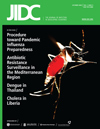A dengue transmission model in Thailand considering sequential infections with all four serotypes
DOI:
https://doi.org/10.3855/jidc.616Keywords:
dengue, inapparent infection, Thailand, antibody-dependent-enhancement, mathematical modelAbstract
Background: Dengue fever/dengue haemorrhagic fever is prevalent in Thailand, where all serotypes are found and the dominant serotype has changed irregularly. Although almost all primary infections present with slight symptoms or are asymptomatic, little is known about the infectiousness of dengue fever.
Methodology: A mathematical model of the transmission for dengue virus was constructed covering the possibility of sequential infections with all four different serotypes. The model was combined with the seasonal population dynamics of Aedes aegypti, the principal vectors of dengue virus in Thailand. The contributions of inapparent cases in the transmission to mosquito vectors and antibody-dependent enhancement were incorporated into the model. Moreover, the hypothesis of an "unnatural" infection route was examined, where a person acquires immunity by infection during a cross-immunity period, through model simulations.
Results: A comparative study on the transmission probabilities of inapparent cases to mosquito vectors showed that the prevalence of dengue infection could be immediately stamped out after a severe outbreak if inapparent cases had no infectiousness. The simulation under an "unnatural" infection route assumption resulted of yearly changes in the dominant serotype and sharp, irregular variations in outbreaks.
Conclusion: The supposition that inapparent cases had no infectiousness was not in accord with the actual situation in Thailand. Furthermore, the simulation result supported the "unnatural" infection route as having an influence on epidemics of dengue.
Downloads
How to Cite
Issue
Section
License
Authors who publish with this journal agree to the following terms:
- Authors retain copyright and grant the journal right of first publication with the work simultaneously licensed under a Creative Commons Attribution License that allows others to share the work with an acknowledgement of the work's authorship and initial publication in this journal.
- Authors are able to enter into separate, additional contractual arrangements for the non-exclusive distribution of the journal's published version of the work (e.g., post it to an institutional repository or publish it in a book), with an acknowledgement of its initial publication in this journal.
- Authors are permitted and encouraged to post their work online (e.g., in institutional repositories or on their website) prior to and during the submission process, as it can lead to productive exchanges, as well as earlier and greater citation of published work (See The Effect of Open Access).








